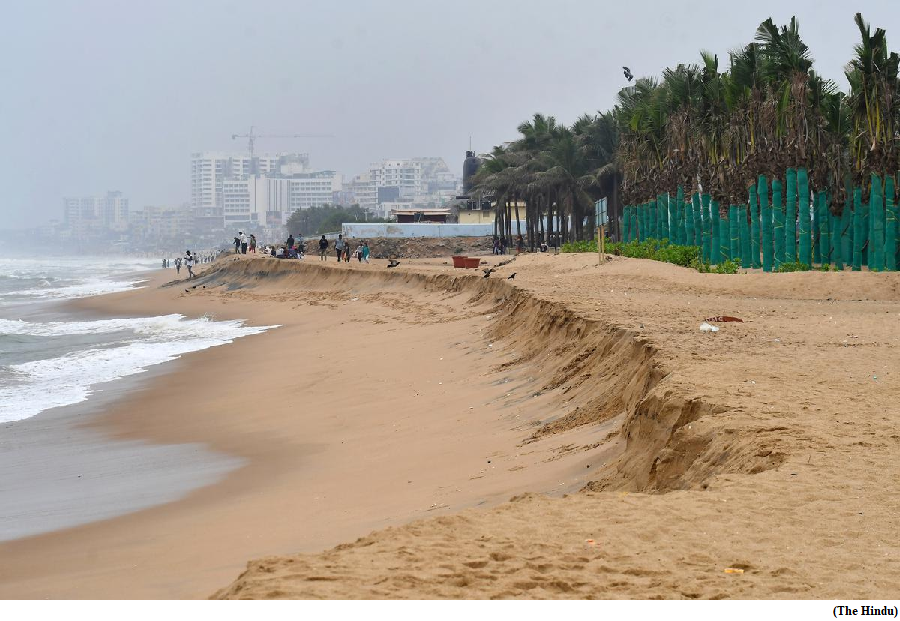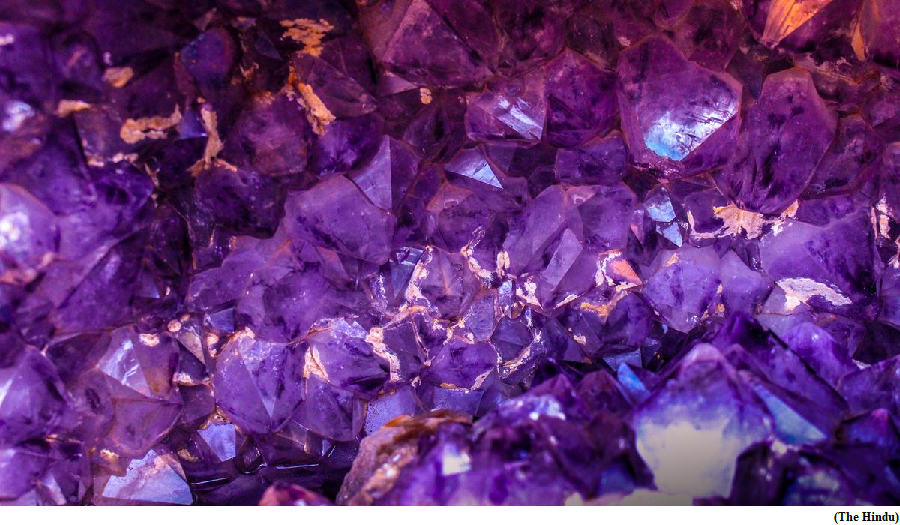Beaches in Visakhapatnam are now heading towards a disaster, say experts (GS Paper 3, Disaster Management)

Why in news?
- Recently, Union Minister of State for Earth Sciences Jitendra Singh said in Rajya Sabha that about 28.81 km of coastline in Visakhapatnam is prone to erosion.
Background:
- The erosion of beaches in Visakhapatnam is not new. It has been since 1930, ever since two ships were sunk near the Dolphin’s Nose to create a breakwater to stop the process of sedimentation at the mouth of the Visakhapatnam harbour, during the construction phase of Viskhapatnam Port.
- This was just the beginning. Erosion aggravated with the construction of two breakwaters during the construction of the Outer Harbour during the 1970s.
Geographical aspect:
- Beaches are dynamic landforms and should be treated as part of the sea and not part of the land.
- The erosion and deposition of sand are primarily due to the high wave action and high wave energy and the problem arises when man meddle with them.
Threat:
- The beaches act as cushion between the high wave action of the sea and the landmass. Continuous nourishment of beaches is a must through the natural process and, if disturbed, they will face severe erosion.
- Due to the construction of the breakwaters on the south side, the sand no longer reaches the beaches in the north, such as RK Beach, and hence the beaches are not nourished.
Way Forward:
- As per the experts about 50 years from now, if adequate precautions are not taken, then RK Beach could become like the Marine Drive of Mumbai.
DRDO asks industry to join fifth generation fighter development
(GS Paper 3, Science and Tech)
Why in news?
- The Aeronautical Development Agency (ADA), under the Defence Research and Development Organisation, has invited Indian industry players to join the development and manufacture of the indigenous fifth generation fighter jet, the Advanced Medium Combat Aircraft (AMCA).

Details:
- Based on the success of the indigenous light combat aircraft, the Centre has entrusted the Agency with the design of a new fighter jet for the Indian Air Force, which will be a fifth generation, medium-weight, multi-role and twin-engine aircraft.
AMCA:
- The AMCA is envisaged as a 25-tonne twin-engine stealth aircraft with an internal weapons bay and diverterless supersonic intake, which has been developed in India for the first time.
- It is intended to have an internal carriage of 1,500 kg of payload and 5,500 kg of external payload with 6,500 kg of internal fuel.
LCA-Mk2:
- In September, 2022 the Cabinet Committee on Security sanctioned the development of the LCA-Mk2, a new light combat aircraft, at a development cost of ₹9,000 crore, of which ₹2,500 crore has already been spent.
- The first prototype is expected to roll out in 2025-26 with the first flight planned for 2026-27.
- The LCA-Mk2 will be a heavier and much more capable aircraft than the current light combat variants as well as the LCA-Mk1A, 83 of which have been contracted under a ₹48,000-crore deal with the Hindustan Aeronautics Ltd. The IAF has given a commitment to procure six squadrons of the LCA-Mk2.
Background:
- India’s ambitious effort to build an indigenous fifth generation fighter, which only a handful of countries have accomplished, is in the critical design review phase and is now awaiting approval from the Cabinet Committee on Security.
- In 2009, the Union government had allocated ₹90 crore for a feasibility study on designing a fifth generation fighter, with an additional ₹447 crore sanctioned later.
- One the project is sanctioned, the first prototype could be rolled out in three years, with the first flight expected to take place in a year to a year-and-a-half after that.
- Hindustan Aeronautics Ltd., the production agency for the project, has already begun manufacturing activities.
Scientists report finding a third natural source of quasicrystals
(GS Paper 3, Science and Tech)
Why in news?
- Scientists have reported finding only the third natural source of quasicrystals, a material once deemed impossible and whose unusual properties scientists are still unravelling.

Quasicrystal:
- In a crystal, the atoms are arranged in a pattern that periodically repeats itself. A quasicrystal’s atoms are arranged in a pattern that repeats itself at irregular intervals.
- Quasicrystals were discovered in the lab in 1982. In the late 1990s, scientists began looking for quasicrystals in nature.
Findings in 2009:
- After a decade-long quest, Luca Bindi, Paul Steinhardt, and others reported finding the first natural quasicrystal in 2009 as microscopic grains in a piece of the Khatyrka meteorite in the Koryak mountains of Russia.
- This meteorite was involved in several collisions in space over millions of years, heating and pressurising it to a great degree and creating the quasicrystals.
- The discovery inspired a series of experiments in which physicists used ‘shock synthesis’ to create new varieties of quasicrystals in the lab.
Findings in 2021:
- In 2021, they reported finding a quasicrystal in the remains of the first nuclear weapon test, conducted on July 16, 1945, in New Mexico.
- They wrote that the material “was found in a sample of red trinitite, a combination of glass fused from natural sand and anthropogenic copper from transmission lines used during the test.”
Recent research:
- Recently, in December 2022, they reported that in the wind-blown dunes of northern Nebraska, they had uncovered a metallic fragment in a long, tube-shaped mass of sand heated and fused by a heavy electric current. They also noticed a power line nearby had fallen to the ground.
- That’s where the metal could have come from, but they couldn’t tell where the current had originated: in the power line or as a lightning strike on a stormy night.
- Whatever the source, it had melted the quartz at the site and formed a silicate glass, a process that needs to happen at least 1,700º C. The metallic portion was a mass of aluminium, chromium, manganese, nickel, and silicon.
- When placed under a powerful electron microscope, they spotted a dodecagonal quasicrystal, rare even for quasicrystals.




